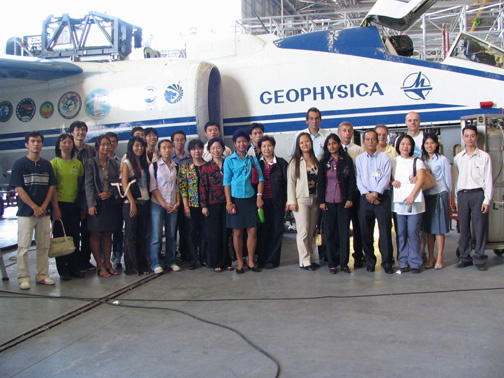
The AIT delegation poses with organizers in front of a modified Russian special military plane, which now serves to promote cutting-edge research to better understand the Earth's atmosphere in a time of global warming.
AIT delegation probes research equipment on a trip to U-Tapao International Airport
On 10 November 2005, an AIT delegation comprised of students, staffs and faculty visited U-Tapao International Airport. The delegation observed the research equipment in 2 planes used for the cooperation research in the European Union project Scout-03 (Stratospheric Climate with Emphasis on the Upper Troposphere and Lower Stratosphere). The cooperation research was held with the cooperation of 60 European research institutes and universities.
The AIT group was welcomed by Joerg Dressler from the German Aerospace Services Ltd. based in Munich, Germany and by Mr. Finkenzeller, a technical director in the project. Dr. Michael Volk, a geophysician from Frankfurt University, Germany, explained the project and research equipment to the delegation.
The planes started from Munich, Germany, on route to Darwin, Australia. One of the airplanes, shown above is a modified former Russian military airplane. It was built during the cold war in the 1980s for very special reconnaissance flights. It can fly up to an altitude of 22,000 m, much higher than conventional airplanes. Due to its specially designed wing profile, it can travel at low velocities (200m/s or 720 km/h) in that altitude. There is only one person on board, the pilot. The airplane has been modified for academic purposes and is now packed with all kinds of instruments to measure the composition of the atmosphere. The plane had to stop-over several time for maintenance of the scientific instruments on the way before reaching the final destination and Thailand is one of those stop-overs. Before touching down in U-Tapao they stopped in Crete (Greece), Dubai and in Hyderabad (Pakistan). The next stop-over will be in Brunei before finally reaching Darwin. About 12 research flights will be carried out, before returning on the same route to Europe.
Several groups of scientists from all over the world are joining this trip (on different airplanes) to conduct research which aims to investigate the atmospheric chemistry and physics of the upper troposphere and lower stratosphere. Both remote (laser, radar etc.) and in-situ measurements are conducted. The latter include the atmospheric gaseous composition (ozone, water vapor, carbon monoxide, hydrocarbons, methane, nitrogen oxides, chlorine oxide and bromine oxide, and others), and the atmospheric aerosol concentration and properties.
The results of the measurements will help scientists to better understand how the composition of the atmosphere being changed and how the changes will affect the Earth's climate. In particular, the research will show how the ozone layer depletion is developing. Distribution of the trace components in the stratospheric atmosphere can also give information on the air movement.
The visitors gained inside views into the research activities and monitoring instruments of this mission.
Dr. U. Glawe (Assoc. Prof. at SET), who lead the visit, gratefully acknowledged on behalf of the visitors and AIT all involved persons and institutions who helped to organize the unique event.
